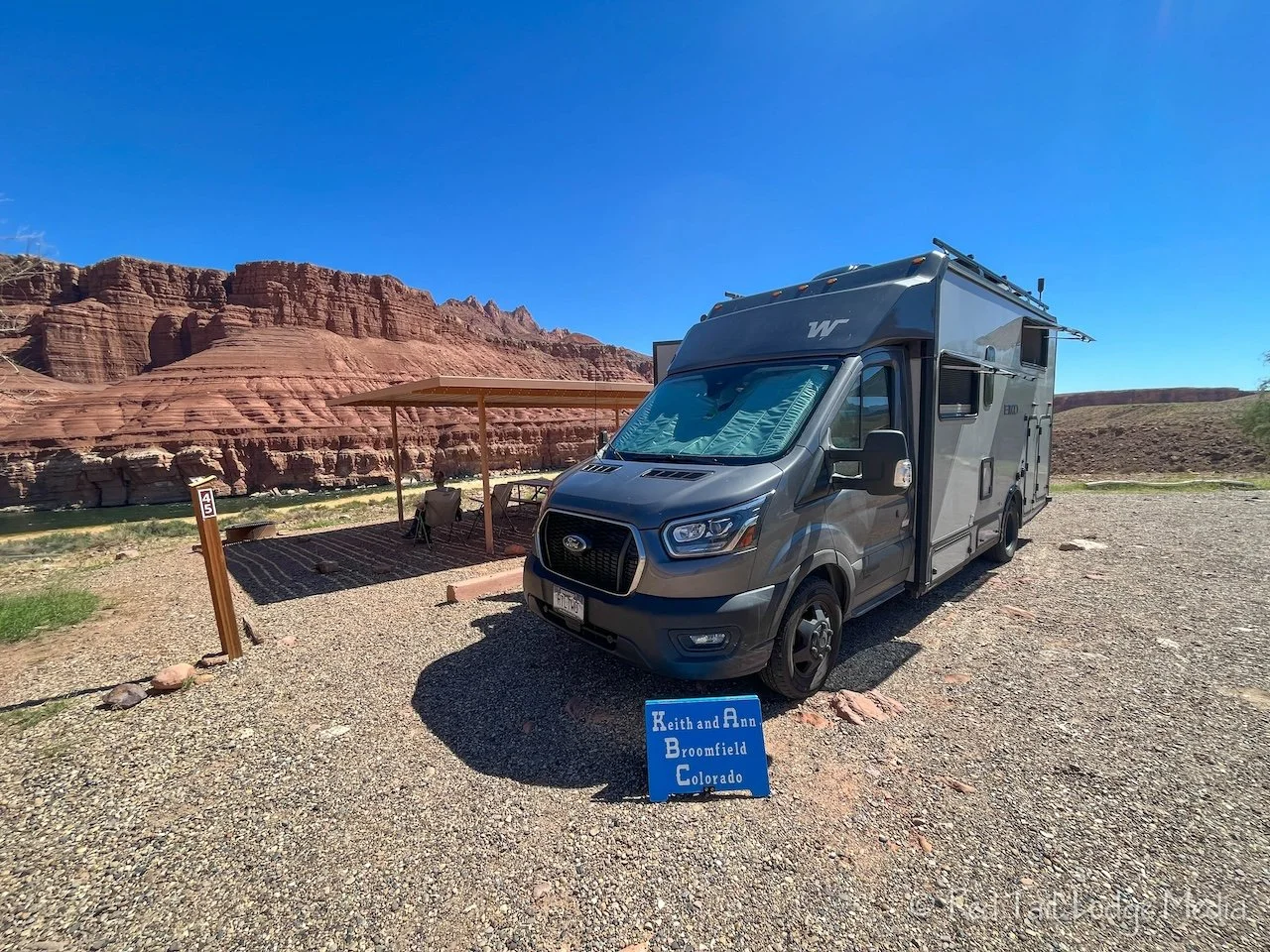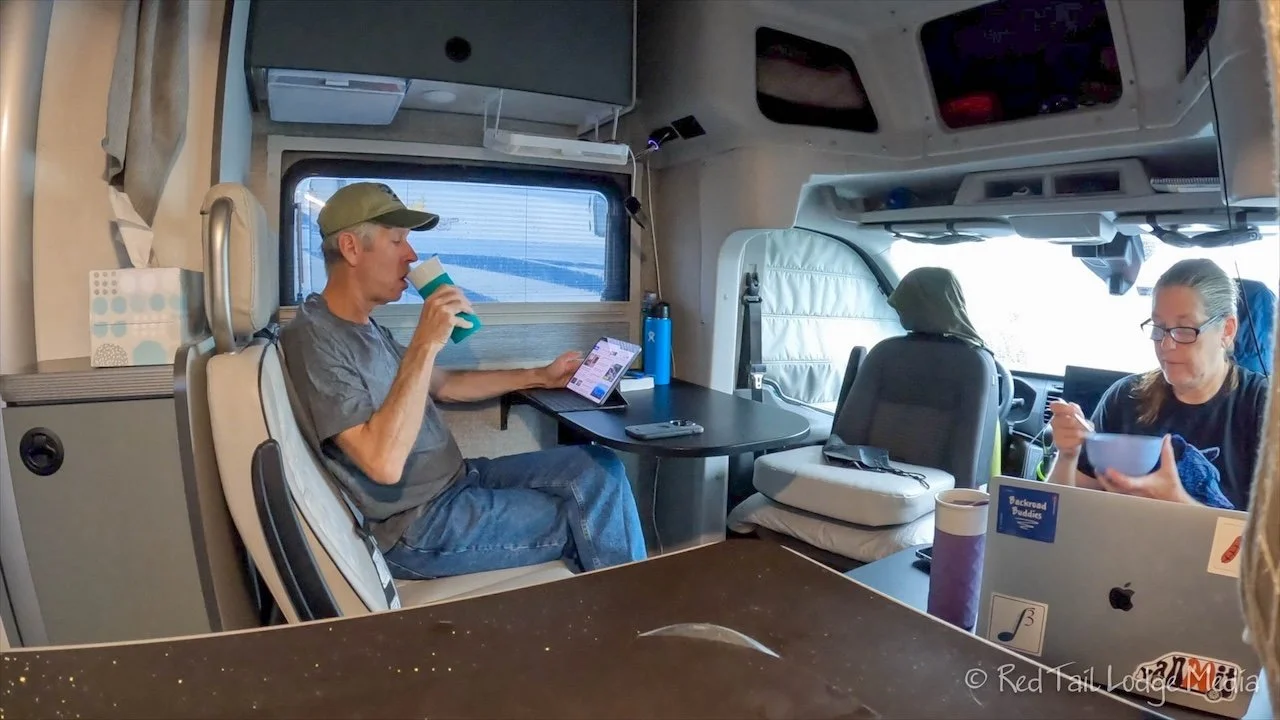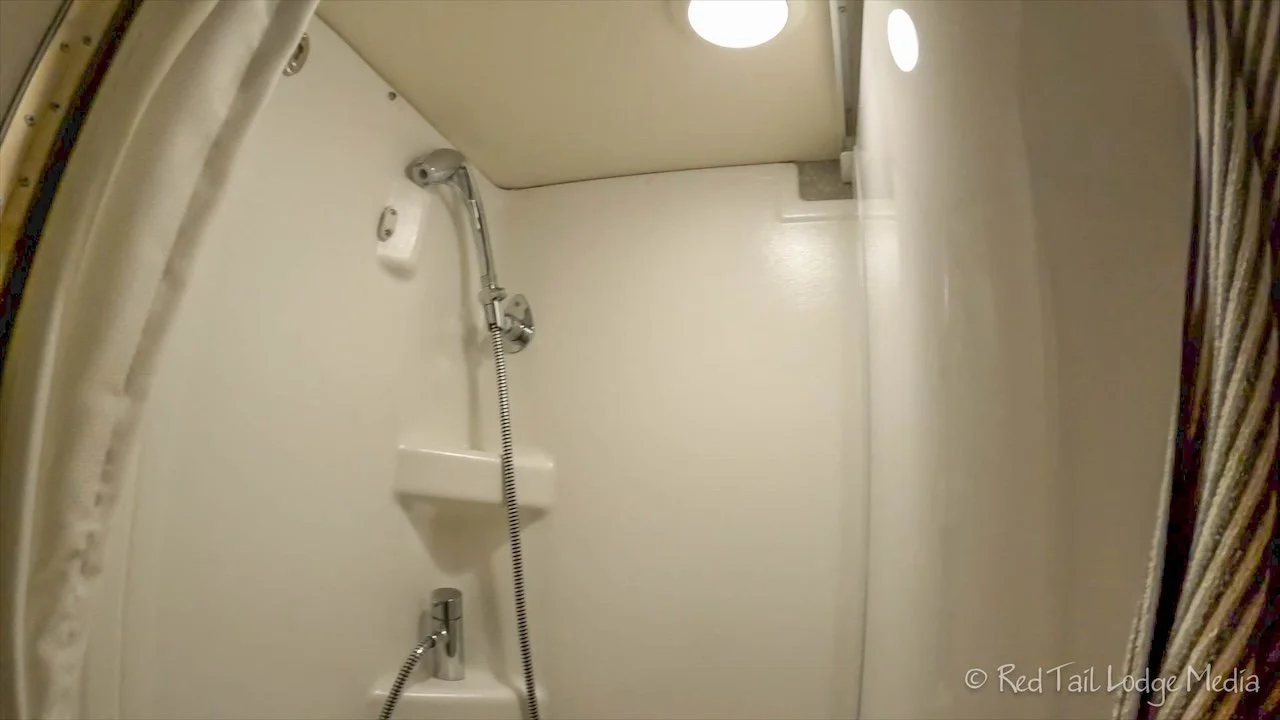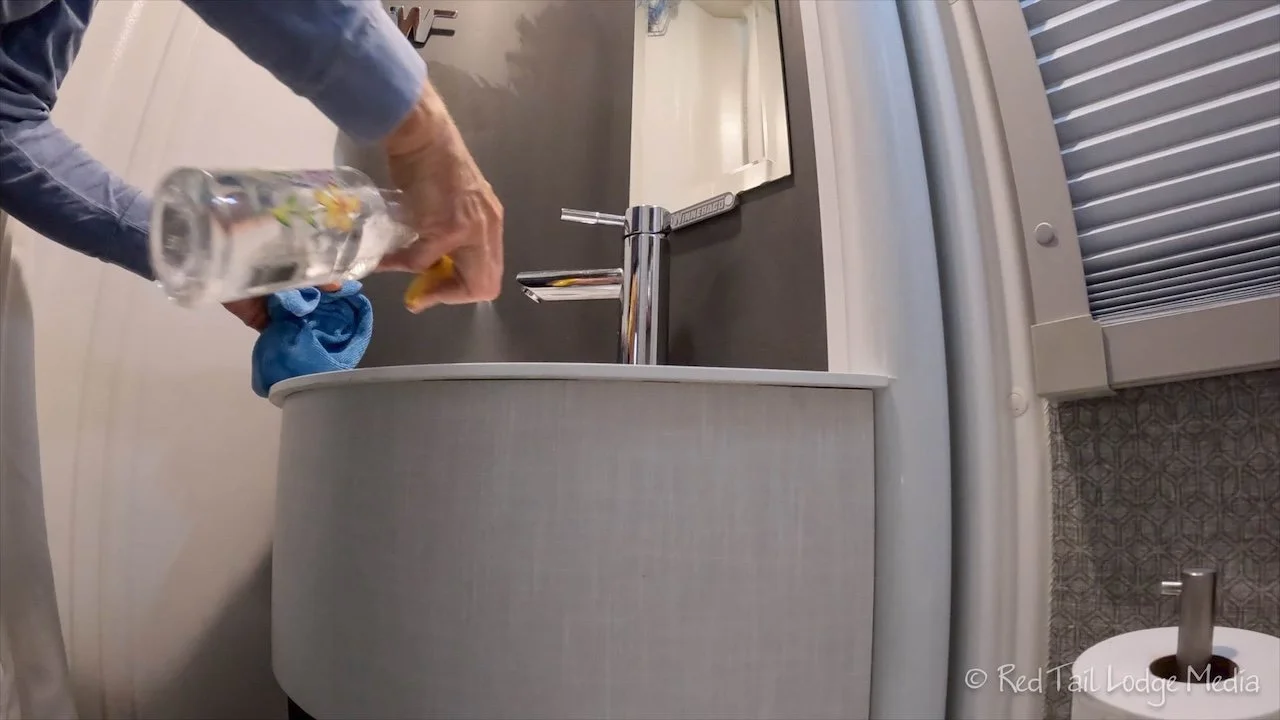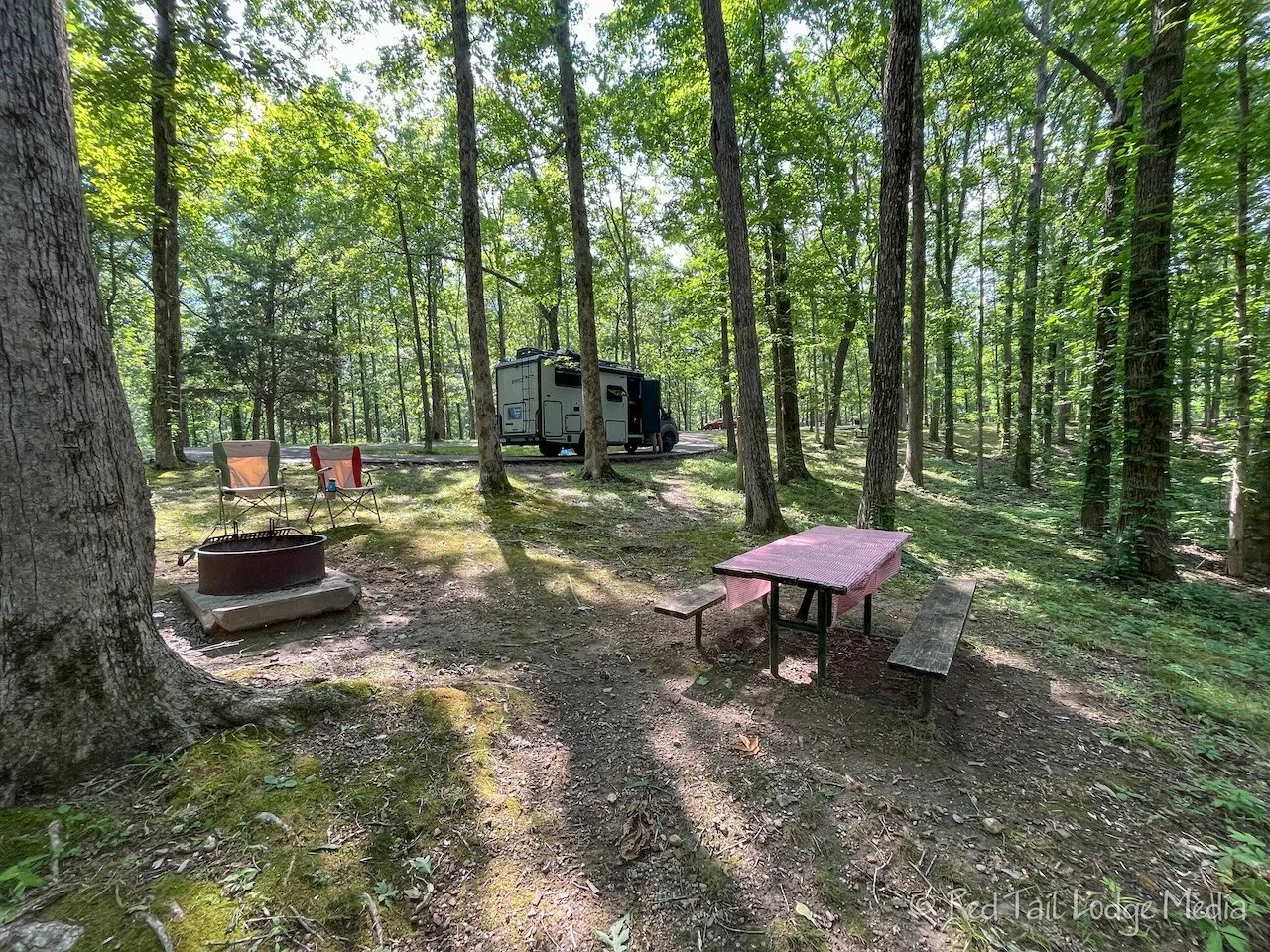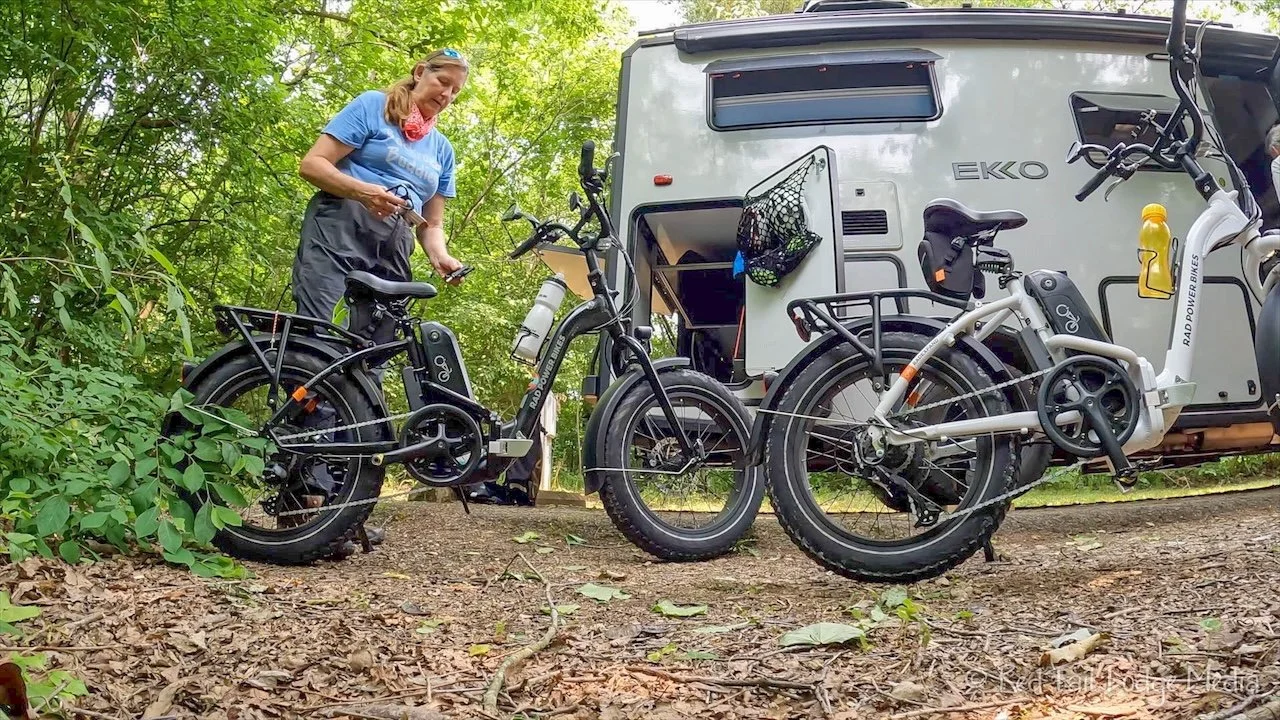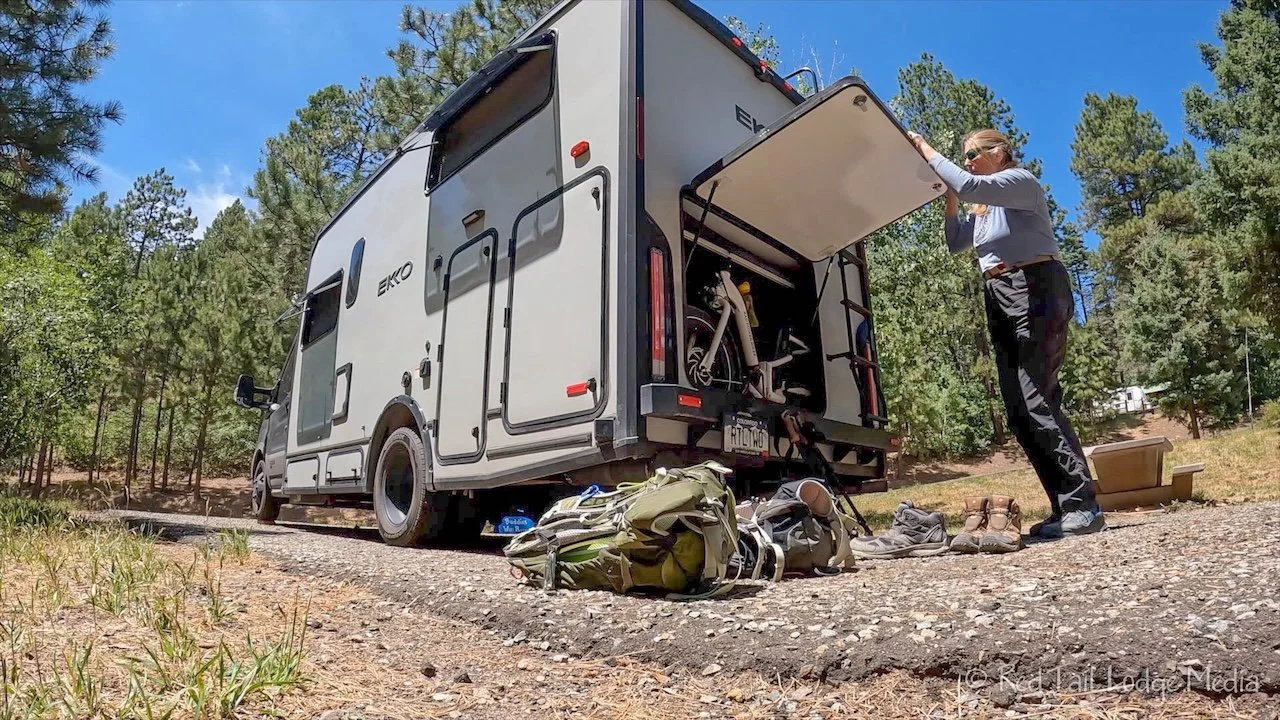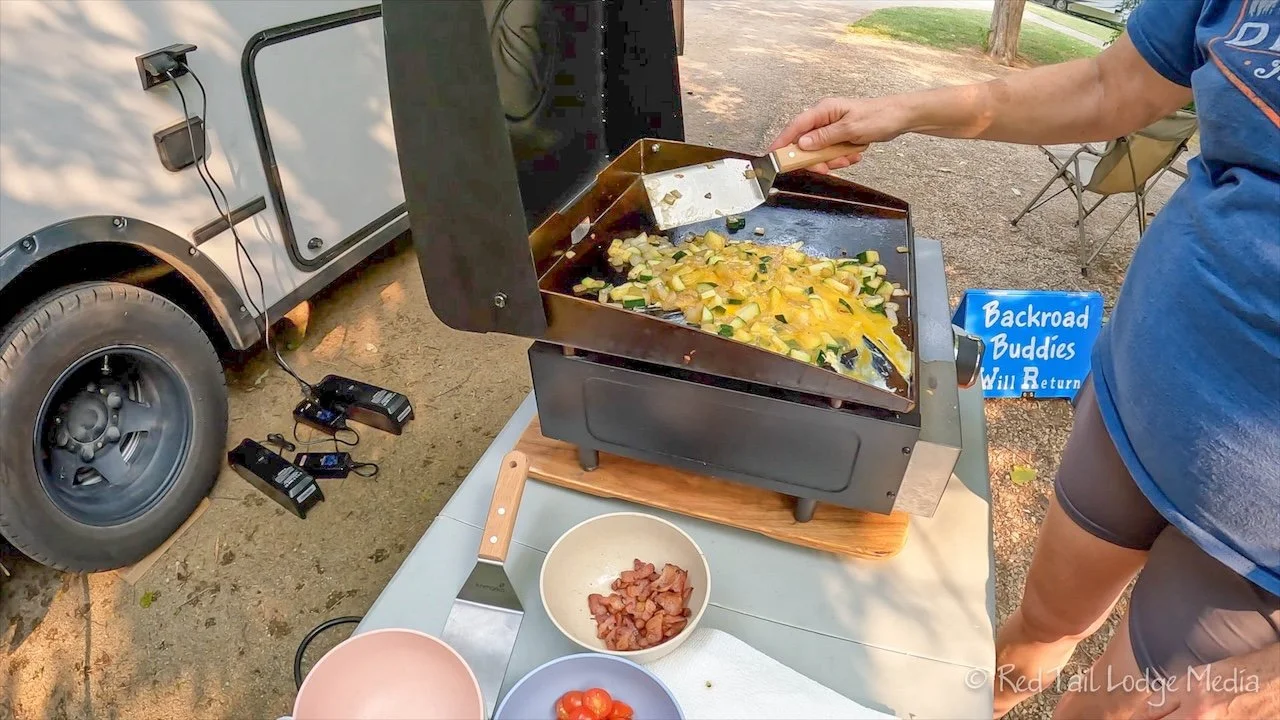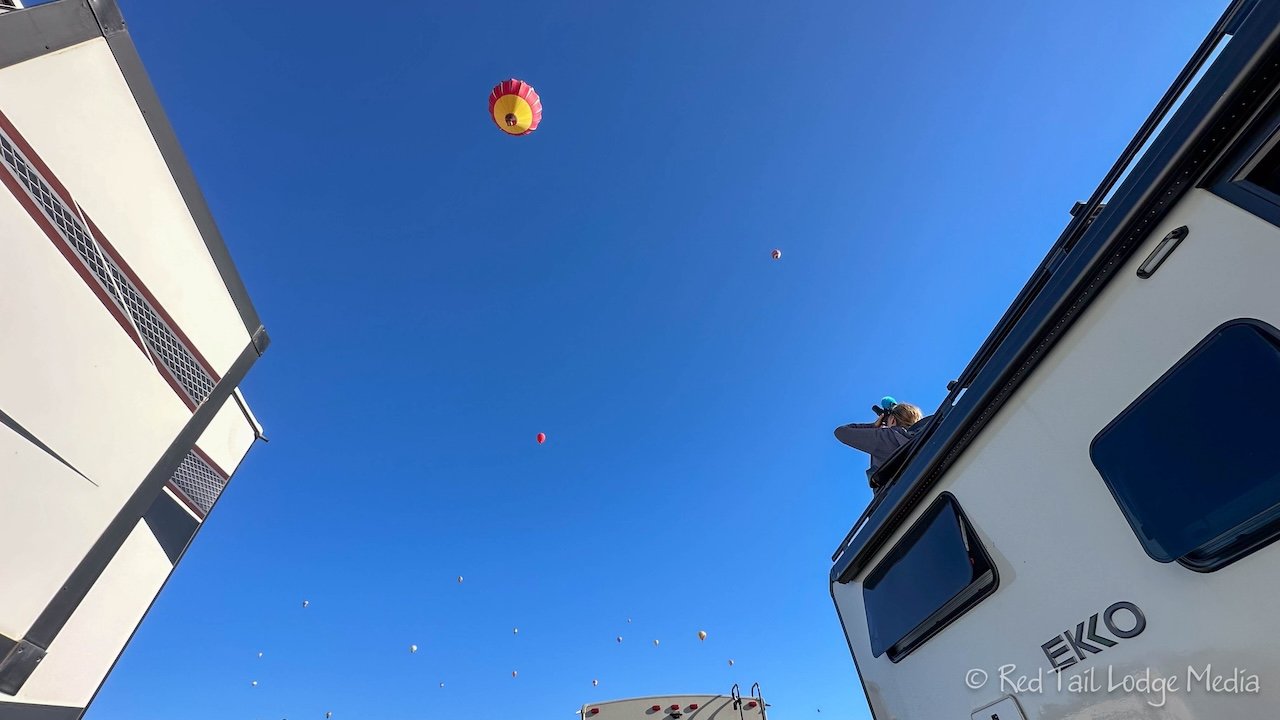Our EKKO Life
Now that we’ve lived in Red Tail (our Winnebago EKKO) for six and a half months straight, we’re sharing what our life on the road looks like. This post is not about the places we traveled, but rather about what our daily routine is. If you have a hard time envisioning what life on the road in an RV would be like, especially in an EKKO, then this post is for you. If you already live on the road, you may be interested in what someone else’s take is on it. No matter the reason for reading this post, we hope you find it useful or interesting.
Morning Routine
We’ll start with our morning routine. Normally, we don’t set an alarm unless we want to get an early start or we have an appointment in the morning. The first person up will go to the dinette area to get dressed and hang out. They will close the curtain across the bedroom doorway to keep from disturbing the person still in bed. After both of us are up, we’ll take down the insulating curtain so we can have access to the passenger seat for more seating.
Keith doesn’t normally eat breakfast. He just drinks coffee in the morning. Because he doesn’t like the hassle of his French press and dealing with the coffee grounds while on the road, he just makes coffee from instant. Ann doesn’t drink coffee but does eat breakfast. Her usual breakfast is yogurt, granola cereal, fresh fruit (usually blueberries), and a glass of juice. If the weather is decent and there aren’t too man bugs outside, we’ll sit in our camp chairs outside in the morning to drink our coffee and eat our breakfast. Otherwise, we’ll just sit inside to eat and drink.
Since our only breakfast dishes are one bowl, one spoon, and a mug or two, Ann quickly washes these out after breakfast, usually using any leftover hot water from our electric tea kettle. Then we brush our teeth. Yes, now you know where we stand. We brush our teeth after breakfast instead of when we first get up.
Showers
We don’t always take showers every day. It depends on how active we have been and how dirty we feel. Sometimes we shower in Red Tail and sometimes we use the campground showers. If the campground showers are nice and it’s not a long walk in bad weather, then we’ll use those to save our fresh tank water for other uses. Plus, the less often we use our own shower, the less often we need to clean it.
When we take a shower in Red Tail, we’ll first turn the water heater to Comfort mode, setting the temperature so that we don’t have to mix any cold water with it. That’s usually around 105 degrees or so. Then we don’t have to waste any water trying to adjust the temperature when we’re in the shower. After taking our showers, we’ll wipe down the walls to get it fairly dry and leave the shower curtain spread out until it dries.
If we’re using the campground showers, we’ll grab one of our reusable grocery bags to collect our clean clothes, shampoo, deodorant, hair brush, and bath towel. On our way out the door, we’ll grab our flip flops from the front side of the dinette seat. We don’t use our shower shoes when taking a shower in Red Tail, but always use the in campground showers.
When we are done with our showers, we’ll hang our bath towels either over the back of our camp chairs outside or over one of the front seats or steering wheel when the weather outside is bad. Our flip flops will dry pretty quickly laying out on a picnic table in the sun or on the floor of the front cab area if we need to bring them inside. Our dirty clothes go into the clothes hamper we have under the foot of the passenger side bed.
Cleaning
There are some things that need to be cleaned on a fairly frequent basis. We typically clean the bathroom and condition the toilet seal about every month or two. To clean the bathroom, we just wipe down all the surfaces with diluted distilled vinegar (a one-to-one ratio with water). The toilet seal is poured into the toilet and allowed to sit for a couple of hours before flushing it.
We sweep the floor when it needs it. It is something we probably should do at least once a day, but we’re too lazy. We’ll wait until we can’t tolerate the dirt on the floor any longer. It is a small space, so it gets dirty pretty fast, but it also doesn’t take long to sweep it. Most of the time we just use a small hand broom and dust pan. For a deeper clean, we also carry and use a small hand vacuum to get the dirt out of the cracks and crevices.
We carry enough clothing with us to last about seven to ten days between laundry days. We prefer to do our laundry at campgrounds as we find it more convenient. It is nice to get a load through while you are eating breakfast. However, not all campgrounds have laundry facilities and some have laundry facilities that are questionable in regard to cleanliness and proper functioning. In those cases, we head to a laundromat. In both cases, quarters are usually needed to operate the machines, although we have come across some that use credit cards, phone apps, or tokens that can be purchased. We keep a container of quarters in our glove compartment for laundry and tolls.
To carry our laundry back and forth to the facilities, we use the removable liner of our clothes hamper along with a laundry backpack. If it will all fit into the backpack, we’ll stuff the liner into the backpack, since it is easier to carry, especially if we need to walk halfway across the campground to reach the laundry room. Normally we’ll wash all of our towels on our laundry days. About once a month, we’ll wash our bed sheets. We don’t carry spare sheets, but we do carry a spare hand towel and wash cloth.
Breaking Camp
When we are packing up to leave a camp site, either just for the day or moving on to a different campground, we have a check list we go through just to make sure we don’t forget anything. Some items are just an inconvenience if we forget. Others have the potential to cause damage, like a window left open. It is a long list, but not everything has to be done every time. It depends on what we have gotten out, hooked up, and the weather.
Most of the items are pretty self-explanatory. We need to move our hanging veggie bag that we use for fresh fruits and vegetables. The position that it is in while we’re camped is too close to the wall and the items might get damaged by bumping into the wall as we drive down the road. The position that it is in for travel is in the way for using the counter when we are camped. Hence, the need to move it each time.
If we are just leaving for the day and will be returning later, we leave our camp sign at our site, indicating we will be returning. This is an issue for most motorized RV’s and camper vans when you don’t have a second vehicle. There is no good way to indicate that the site is still occupied. When we were in our camper van, we’ve had items taken from our camp site a few separate times and once someone set up camp in our site. Our camp sign hopefully clearly communicates that our site is occupied and reduces those types of incidents.
Here is our Breaking Camp Check List:
fill water bottles for the road
turn off ceiling fan
turn off furnace
turn off air conditioner
turn off water heater
turn off propane
unplug from shore power
turn off weBoost (cell signal amplifier)
put away hand soap (so it doesn’t fall off the sink counter)
turn off water pump
close all windows
open all blinds
put away front window shades
put down dinette table
put away tea kettle
cover sink
move veggie bag (one position for camp, another position for travel)
put away Lagun table
turn seats back around
empty the trash
turn off inverter
turn off interior lights
verify all cabinet doors and drawers are closed and secure
put camera within reach
unlock steps
put rug away
put away camp chairs
pack up picnic table cloth
put away sand-free mat
put away camp sign or turn sign around (which indicates we’re coming back)
close awning
lock all exterior compartments
pull tag from camp site post and turn in
if below freezing during drive, put water heater flue plug in and set water heater to antifreeze
clean windshield
lock entry door
walk around
remove leveling blocks
turn on TPMS (Tire Pressure Monitoring System)
turn on headlights
dump toilet cassette
dump gray water tank
fill up fresh water
text kids we’re starting a drive
Midday Routine
We typically only cook dinner. We like different things for lunch so we each make our own. Keith prefers cold items, like lunchmeat sandwiches, carrots and celery. Ann likes to eat leftovers, salads, cucumbers and tortillas with hummus, or nachos with cheese melted in the microwave along with guacamole and salsa. We prefer eating lunch outside when the location and weather cooperate. Otherwise, we’ll sit inside at the dinette and Lagun table. If it is a travel day, we won’t bother turning the seats around for lunch and just sit next to each other at the dinette table on the bench seat. Since we don’t have many dirty dishes from lunch and we don’t like doing dishes more than once a day, we’ll wipe them off and put them in the kitchen sink. We’ll more thoroughly wash them after dinner along with the dinner dishes.
If we need to refill the ice cube trays, we’ll wait until Red Tail will be stationary for a while. We haven’t tried driving with the trays full of water to see if they would spill in the freezer, but we didn’t want to take the risk.
Normally our trips to the grocer store were on travel days. We found this more convenient than breaking camp just to make a grocery run. We would find a store along our route along our way to the next campground. Usually we move campgrounds every three to five days. Ann would plan out our meals for the length of time we planned on being at the next campground and created a grocery list from her plan. We keep a small bag that contains several reusable grocery bags that we can easily grab as we head into the store. It is nice to be able to put the groceries away right away as our rig is parked in the store parking lot.
Setting Up Camp
When we arrive at the next campground, there are some items we always do. However, we normally wait until we have a need for something before getting it out, setting it up, or turning it on. Therefore, if we didn’t need or use it, we don’t have to put it away.
Things we always do when we arrive:
text kids we’ve arrived
turn seats around (sometimes only the passenger seat)
set up dinette table
set up Lagun table
put out hand soap
uncover sink
move veggie bag
lock steps
turn on weBoost (cell signal amplifier)
check cell signals
turn off TPMS (Tire Pressure Monitoring System)
turn off headlights
turn on propane
turn on water heater
level rig, if needed
remove water heater flue plug (if it was installed when breaking camp earlier that day)
Things we wait to do until needed:
turn on water pump when we need to use a faucet or shower
put front window shades in when needed to reduce heat gain or loss, or for privacy
open windows if more ventilation is desired or we want to listen to the sounds of nature
turn on fan if ventilation is needed
plug into shore power, if we want to run AC or our house batteries are low
turn on air conditioner when fans and open windows are not enough
put out camp chairs when we want to sit outside
get out the Thermacell if the bugs are bad
put out sand-free mat if there is room and the ground outside Red Tail is dirty, sandy, or muddy
put out awning if it is not windy and we need the shade either to sit in or to shade Red Tail to reduce heat gain
hook up to city water if desired, we actually prefer filling our fresh tank and using the water from the tank
put table cloth on picnic table if it is dirty and we want to eat or work outside
Activities
If it is not a travel day, then we usually do some kind of activity during the day, such as biking, hiking, paddle boarding, or just strolling around a town or city. We travel with gear for these activities that we’ve stored out of the way but still kept easy to access.
Biking
Our two Rad Expand 5 e-bikes are stored in the gear garage. In order to get them to fit, we have to fold down the handle bars, lower the bike seats, and remove the quick-release pedals. Tracks were installed on the floor of the gear garage to allow the bikes to easily roll into and out of the storage area, with chocks at one end to stabilize the bikes once they are all the way in. Ratchet straps secure the bikes during travel. For more details of our setup, see Our EKKO Modifications blog post.
Our bike helmets and gloves are stored in a net hanging on one of the gear garage doors. Our saddle bags, which store our pedals and bike locks, hang from the L-track inside the gear garage. In addition, our bike battery chargers are stored on the floor of the gear garage.
When we want to charge our bikes, we pull the batteries off the bikes and plug the chargers into the AC outlets on the outside of Red Tail, laying the chargers and the batteries on the ground next to the rig. We only charge the batteries when we are hanging out at our camp site so we don’t run the risk of them being stolen. It would be too easy for someone to come along and walk off with the batteries and chargers.
Hiking
Most of our hiking gear is also stored in the gear garage. Our backpacks hang from the L-track at one end of the gear garage. Our hiking boots sit between the tracks for the e-bikes. Initially, we stored our trekking poles at the opposite end of the gear garage from our backpacks. However, we soon got tired of opening up all three gear garage doors to fetch our hiking gear. So we moved our trekking poles to the middle of the gear garage alongside the bike tracks, near our hiking boots.
We keep most of our hiking gear inside our backpacks (Hiking Ten Essentials). When we want to hike, all we need to add is food, water, rain gear, our Garmin InReach (paid link), and any extra clothing we may need that day. We like keeping our gear in the gear garage, especially if it gets wet, dirty, or muddy. That way we aren’t tracking that dirt and water inside Red Tail.
Paddle Boarding
Keith does not paddle board, just Ann. Paddle boarding is the activity we do the least often, so it is the gear that is the hardest to get out. Most of the paddle board equipment is stored on the roof inside our Roof Bag (paid link). To get it out, Ann climbs up the ladder to the roof and hands the items out of the bag down to Keith who is standing below. It is not difficult or time-consuming. The only issue is when the black ladder sits out in the sun and gets extremely hot.
Ann’s life jacket (paid link), dry sacks, floating cell phone pouch (paid link), and camera floats (paid link) hang from the L-track inside the gear garage. She also stores her water shoes on the floor of the gear garage.
Our paddle board (paid link) is inflatable. With the provided hand pump, it only takes about five minutes or so to fully pump it up. However, if it’s hot outside, Ann usually works up a sweat while pumping.
When Ann is done paddling for the day, she uses our coiled hose (paid link) and sprayer to rinse off all the gear, including the board and her body. She connects the hose up to the camp site water connection, if there is one, or to the quick connect inside the water compartment of Red Tail.
After everything has dried, Ann packs everything back up. The board deflates in seconds. We then reverse the procedure from when we got everything out. Ann climbs back up on the roof. Keith hands her all the paddle board items and she places them back in the roof bag. If the life jacket and water shoes are not completely dry, that’s OK as they will finish drying inside the gear garage. Ann either lays her bathing suit outside to dry or brings it inside to hang on the retractible clothes line inside our bathroom.
Evening Routine
As the day winds down, we settle into our evening routine. Ann usually works on a blog post or video in the dinette area while Keith relaxes on his bed, perhaps watching a video on his iPad or listens to a podcast.
For dinner, we’ll use the propane stove or the microwave to cook inside, use our Blackstone griddle (paid link) to cook outside, or use our induction cook top (paid link) or Instant Pot (paid link) to cook either inside or outside. Which method of cooking we use is determined by what we are cooking, what the conditions are outside, how much propane we have, if we have electrical hookups or not, and how much charge is left on our house batteries. If we’re using the induction cook top and/or Instant Pot and we have another large electrical draw at the same time, like the air conditioner, we will use the 20A outlet on the camp site pedestal to keep the cook top or Instant Pot on a separate circuit to reduce the load on Red Tail’s electrical system.
The kitchen inside is a little tight for two people to be cooking at the same time, so Ann is usually the one doing most of the cooking. However, she loves cooking dinner on the Blackstone griddle, because she can get Keith more involved. He’ll usually be the one to set up the griddle, clean it, and put it away. Since no pots are needed to cook on the griddle, that means no pots to clean afterwards. Plus, Keith will start cooking items on the griddle while Ann is inside prepping the rest of the ingredients.
Just like breakfast and lunch, if it’s nice outside, we’ll eat outside. Otherwise, we’ll eat inside at the dinette and Lagun table. If we’ve turned the driver’s seat around, we may even both sit at the dinette table for dinner.
Washings dishes is a joint effort. We’ll pile the dirty dishes up on top of the stove. Ann will fill up the sink for washing the dishes and fill up our large plastic bin with rinse water. The bin goes on top of the Lagun table, right next to the sink. Ann will wash the dishes and Keith will dry them. Keith uses the dinette table to temporarily store the clean dishes as he dries them before we put them away where they belong.
After dinner, Ann likes to do her nightly stretches. Well, she likes to stretch daily, but she hasn’t been very good about doing them while we’re on the road. She has a large yoga mat (paid link), stored in the gear garage, for stretching out on. However, her long limbs overhang the mat, so she has been making excuses not to stretch more often than not. It’s too hot outside, too cold, too wet, too dirty, too muddy, or too buggy. Having the sand-free mat out to put the yoga mat on top of helps eliminate some of the excuses. She plans on setting up the sand-free mat more often going forward so hopefully she will stretch more often. She feels so much better when she does and sleeps much better at night with less aches and pains.
If we want a snack or dessert in the evening, it is usually ice cream, as we always keep our freezer stocked with Blue Bell ice cream, typically vanilla. On occasion, we will pop popcorn or make apple brownies. For making popcorn, we use a silicone microwave popper. Just pour in the loose kernels and stick it in the microwave. We generally top the popcorn with melted butter and a little sugar. Ann tries to keep her salt intake to a minimum as high blood pressure runs in her family.
Ann makes apple brownies in the Omnia Oven (paid link), a stove-top oven. Apple brownies have no chocolate in them, just a mixture of chopped apples, flour, eggs, butter, sugar, vanilla, baking powder, baking sugar, and cinnamon, baked into a hot, bubbling goodness. A great way to use up a couple of apples that may be getting a little old. It’s even better with a scoop of ice cream on top.
Just before going to bed, we’ll put up the insulating curtain. It not only insulates the living space from the uninsulated front cab area, but also adds better privacy than the front cab window shades which we may or may not have put in the windows that day.
The last thing we do before crawling under the covers for the night is to watch one or two videos together. We’ll put our laptop in between our beds and we’ll sit up in bed, with our backs up against the front wall of the bedroom. Keith has a cupholder (paid link) on the wall next to him for a drink while Ann’s cupholder is on the wall in the hallway. Hers is a little more awkward to use than Keith’s, but there is no room on the outside wall on her side of the bedroom to install a cupholder.
Conclusion
There is a lot of variety along with a lot of decisions to make while living on the road. Having a daily routine along with good organization provides some structure and helps prevent decision fatigue. We hope we’ve provided you with insight into living on the road or given you ideas on how to create your own daily routines. Happy trails!
If you want more visuals, check out our related video: Our EKKO Life
(Ann)

